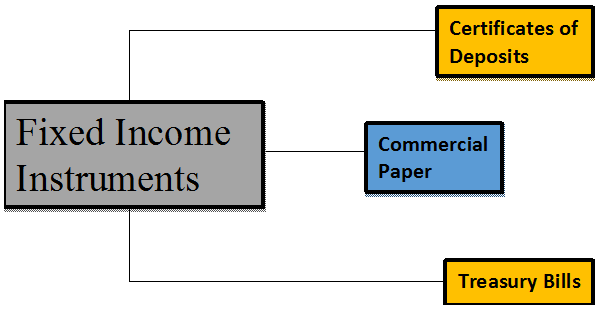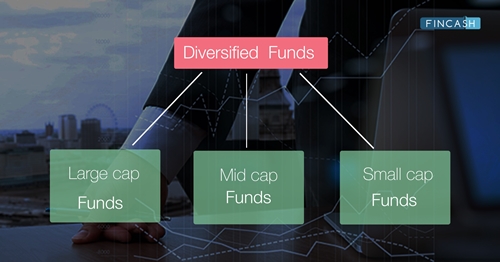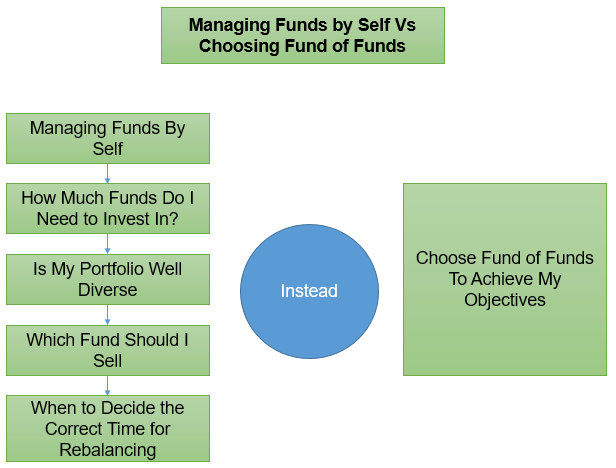What are Money Market Funds?
A money Market fund (MMF) is a type of fixed Income mutual fund that invests in debt securities. But, before we start with money market funds, it's important to understand what is a fixed income instrument? Well, as the name denotes, a fixed income instrument is something that generates a specified amount of income over a certain period. The investor is given a fixed claim on the assets held by the issuer, fixed income instruments are considered low-risk and low-yield investments. Essentially, fixed income instruments are nothing, but a way of borrowing funds (where the borrowing is done by the issuer).

Fixed Income Vs Stocks
For starters, fixed income gives economic rights to the holder, which includes the right to receive interest payments and the return of all or part of Capital invested at a given date. In contrast, the shareholder (stock owner) receives dividends from the issuer, but the company is not bound by any law to pay dividends. Also, another important difference is that the fixed income holder is a creditor of the company that issues the security, while a shareholder is a partner, owning a part of the capital stock. Here it’s important to understand that if the company goes bust, the creditors (bondholders) have priority over shareholders (equity holders).
Types of Fixed Income Instruments
There are different fixed income instruments that fall under money market instruments, to name some of them:
Certificates of Deposits (CDs)
Time deposits like term deposits are commonly offered to consumers by banks (scheduled commercial banks) & all India financial institutions. The difference between this and a term deposit in a Bank is that CDs can’t be withdrawn.
Commercial Paper (CPs)
Commercial papers are usually known as promissory notes which are unsecured and are generally issued by companies and financial institutions, at a discounted rate from their Face Value. The fixed maturity for commercial papers is 1 to 270 days. The purposes for which they are issued are - for inventory financing, accounts Receivables, and settling short-term liabilities or loans.
Treasury Bills (T-Bills)
Treasury bills were first issued by the Indian government in 1917. Treasury bills are short-term financial instruments that are issued by the Central Bank of the country. It is one of the safest money market instruments as it is void of market risks (since the risk is sovereign or in this case the Government of India), though the return on investments is not that huge. Treasury bills are circulated by the primary as well as the secondary markets. The maturity periods for treasury bills are respectively 3-month, 6-month, and 1-year.
There are lots of other fixed income instruments such as repurchase agreements (repos), asset-backed securities etc., that also exist in the Indian fixed income market, but the above are the more common ones.
Talk to our investment specialist
Why to Invest in Money Market Mutual Funds?
- Securities in the money market are relatively low risk.
- Money market funds are considered to be the safe and secure of all Mutual Fund investments.
- Considering money market funds, it’s easy to invest in a money market account. Investing through Mutual Funds investors can open an account, make deposits and withdrawals virtually at their convenience.
- Money market funds are considered to be one of the least volatile types of all mutual fund investments.
- The performance of money market funds is closely tied to the interest rates set by the Reserve Bank of India, the Central Bank of India. So, when RBI raises rates in the market, yields increase, and money market funds are able to give good returns.
Money Market Instruments & Bonds: The Difference
Bonds have a maturity period of more than one year which differentiates it from other debt securities like commercial papers, treasury bills and other money market instruments which typically have a maturity period of less than one year.
What is Money Market?
Money market generally refers to a section of the financial market where financial instruments with smaller maturities (less than a year) and high liquidity are traded. India has a very active money market, where a host of instruments are traded. Here you have Mutual Fund companies, government banks and various other large domestic institutions participating. The money market has become a component of the financial market for buying and selling of securities of short-term duration, such as commercial papers and treasury bills.
Money Market Rates
The money market rates are the interest rates offered by short-term money market instruments. These instruments have a maturity ranging from 1 day to one year. The money market rates vary over many complex instruments such as treasury bills, Call money, Commercial Paper (CP), certificates of deposits (CDs), repos, etc. The Reserve Bank of India (RBI) is largely the governing authority over the money markets.
An example of the money market rates of various instruments as given on the RBI site as of 28th Feb 2017 is below for reference.
| Volume (One Leg) | Weighted Average Rate | Range | |
|---|---|---|---|
| A. Overnight Segment (I+II+III+IV) | 553,584.29 | 6.64 | 4.60-6.86 |
| I. Call Money | 16,300.98 | 6.67 | 4.60-6.85 |
| II. Triparty Repo | 376,743.10 | 6.64 | 6.56-6.80 |
| III. Market Repo | 160,540.21 | 6.65 | 6.00-6.86 |
| IV. Repo in Corporate Bond | 0.00 | - | - |
| B. Term Segment | |||
| I. Notice Money** | 109.00 | 6.27 | 6.00-6.70 |
| II. Term Money@@ | 351.00 | - | 6.40-7.00 |
| III. Triparty Repo | 55.00 | 6.60 | 6.60-6.60 |
| IV. Market Repo | 1,075.00 | 6.76 | 6.75-6.85 |
| V. Repo in Corporate Bond | 0.00 | - | - |
Source: Money Market Operations, RBI Date: 27 Feb 2023
Mutual Fund Companies Offering Money Market Funds
As we have learnt about various types of instruments above, it’s equally important to know how an investor could invest in money market funds. There are 44 AMCs (Asset Managment Companies) in India, most of them Offering money market funds (mainly Liquid Funds and ultra-short funds for investors). Investors can also invest via distributors like banks and brokers. Investing in money market funds requires one to follow the respective procedure and the relevant applications. The terms & conditions of debt mutual funds may vary, therefore, it’s important to get an overall knowledge and then choose the one that meets your needs. Moreover, before investing into any money market mutual funds carefully consider its investment objectives, risks, returns, and expenses.
Factors to Consider for Investing in MMFs
Here are some important aspects that you must consider before investing in money market funds in India:
a. Risks and Returns
Money Market Funds are Debt fund and hence carry all the risks applicable to debt funds like interest rate risk and credit risk. Additionally, the fund manager might invest in instruments with a slightly higher risk component to increase returns. Usually, money market funds tend to offer better returns than a regular Savings Account. The Net Asset Value or NAV of these funds changes with a change in the interest rate regime.
b. Expense Ratio
Since the returns are not very high, the expense ratio plays an important role in determining your Earnings from a money market fund. Expense Ratio is a small percentage of the total assets of the fund charged by the fund house towards fund management services. Ideally, you should look for funds with a lower expense ratio to maximize your returns.
c. Invest according to your Investment Plan
Usually, money market funds are recommended to investors with an investment horizon of 90-365 days. These schemes can help you diversify your portfolio and help invest surplus cash while maintaining liquidity. Ensure that you invest according to your Investment plan.
d. Taxation
In the case of Money Market Funds, the taxation rules are as follows:
Capital Gains Tax
If you hold the units of the scheme for a period of up to three years, then the Capital Gains earned by you are called short-term capital gains or STCG. STCG is added to your Taxable Income and taxed as per the applicable income tax slab. If you hold the units of the scheme for more than three years, then the capital gains earned by you are called long-term capital gains or LTCG. It is taxed at 20% with indexation benefits.
Best Money Market Funds to Invest in FY 25 - 26
Some of the best money market funds in India are as follows-
Fund NAV Net Assets (Cr) 3 MO (%) 6 MO (%) 1 YR (%) 3 YR (%) 2024 (%) Debt Yield (YTM) Mod. Duration Eff. Maturity UTI Money Market Fund Growth ₹3,174.95
↑ 0.07 ₹20,352 1.5 3 7.5 7.6 7.7 6.26% 4M 24D 4M 24D Franklin India Savings Fund Growth ₹51.6214
↓ 0.00 ₹4,440 1.5 2.9 7.5 7.5 7.7 6.19% 4M 17D 4M 24D ICICI Prudential Money Market Fund Growth ₹390.596
↑ 0.02 ₹35,011 1.5 2.9 7.5 7.5 7.7 6.23% 4M 7D 4M 16D Nippon India Money Market Fund Growth ₹4,272.15
↓ -0.26 ₹23,261 1.5 2.9 7.5 7.5 7.8 6.33% 4M 27D 5M 6D Tata Money Market Fund Growth ₹4,859.01
↓ -0.59 ₹38,053 1.5 2.9 7.5 7.5 7.7 6.28% 5M 9D 5M 9D Note: Returns up to 1 year are on absolute basis & more than 1 year are on CAGR basis. as on 9 Dec 25 Research Highlights & Commentary of 5 Funds showcased
Commentary UTI Money Market Fund Franklin India Savings Fund ICICI Prudential Money Market Fund Nippon India Money Market Fund Tata Money Market Fund Point 1 Bottom quartile AUM (₹20,352 Cr). Bottom quartile AUM (₹4,440 Cr). Upper mid AUM (₹35,011 Cr). Lower mid AUM (₹23,261 Cr). Highest AUM (₹38,053 Cr). Point 2 Established history (16+ yrs). Oldest track record among peers (23 yrs). Established history (19+ yrs). Established history (20+ yrs). Established history (22+ yrs). Point 3 Top rated. Rating: 3★ (lower mid). Rating: 4★ (upper mid). Rating: 3★ (bottom quartile). Rating: 3★ (bottom quartile). Point 4 Risk profile: Low. Risk profile: Moderately Low. Risk profile: Low. Risk profile: Low. Risk profile: Low. Point 5 1Y return: 7.54% (top quartile). 1Y return: 7.48% (upper mid). 1Y return: 7.48% (lower mid). 1Y return: 7.48% (bottom quartile). 1Y return: 7.46% (bottom quartile). Point 6 1M return: 0.53% (top quartile). 1M return: 0.51% (bottom quartile). 1M return: 0.52% (upper mid). 1M return: 0.51% (lower mid). 1M return: 0.50% (bottom quartile). Point 7 Sharpe: 2.90 (top quartile). Sharpe: 2.66 (bottom quartile). Sharpe: 2.71 (bottom quartile). Sharpe: 2.74 (lower mid). Sharpe: 2.79 (upper mid). Point 8 Information ratio: 0.00 (top quartile). Information ratio: 0.00 (upper mid). Information ratio: 0.00 (lower mid). Information ratio: 0.00 (bottom quartile). Information ratio: 0.00 (bottom quartile). Point 9 Yield to maturity (debt): 6.26% (lower mid). Yield to maturity (debt): 6.19% (bottom quartile). Yield to maturity (debt): 6.23% (bottom quartile). Yield to maturity (debt): 6.33% (top quartile). Yield to maturity (debt): 6.28% (upper mid). Point 10 Modified duration: 0.40 yrs (lower mid). Modified duration: 0.38 yrs (upper mid). Modified duration: 0.35 yrs (top quartile). Modified duration: 0.41 yrs (bottom quartile). Modified duration: 0.44 yrs (bottom quartile). UTI Money Market Fund
Franklin India Savings Fund
ICICI Prudential Money Market Fund
Nippon India Money Market Fund
Tata Money Market Fund
To provide highest possible current income consistent with preservation of capital and providing liquidity from investing in a diversified portfolio of short term money market securities. Below is the key information for UTI Money Market Fund Returns up to 1 year are on (Erstwhile Franklin India Savings Plus Fund Retail Option) Aims to provide income consistent with the prudent risk from a portfolio comprising substantially of floating rate debt instruments, fixed rate debt instruments swapped for floating rate returns, and also fixed rate instruments and money market instruments. Research Highlights for Franklin India Savings Fund Below is the key information for Franklin India Savings Fund Returns up to 1 year are on The objective of the Plan will be to seek to provide reasonable returns, commensurate with low risk while providing a high level of liquidity, through investments made primarily in money market and debt securities. Research Highlights for ICICI Prudential Money Market Fund Below is the key information for ICICI Prudential Money Market Fund Returns up to 1 year are on (Erstwhile Reliance Liquidity Fund) The investment objective of the Scheme is to generate optimal returns consistent with moderate levels of risk and high liquidity. Accordingly, investments shall predominantly be made in Debt and Money Market Instruments. Research Highlights for Nippon India Money Market Fund Below is the key information for Nippon India Money Market Fund Returns up to 1 year are on (Erstwhile Tata Liquid Fund) To create a highly liquid portfolio of good quality debt as well as money market instruments so as to provide reasonable returns and high liquidity to the unitholders. Research Highlights for Tata Money Market Fund Below is the key information for Tata Money Market Fund Returns up to 1 year are on 1. UTI Money Market Fund
UTI Money Market Fund
Growth Launch Date 13 Jul 09 NAV (09 Dec 25) ₹3,174.95 ↑ 0.07 (0.00 %) Net Assets (Cr) ₹20,352 on 31 Oct 25 Category Debt - Money Market AMC UTI Asset Management Company Ltd Rating ☆☆☆☆ Risk Low Expense Ratio 0.25 Sharpe Ratio 2.9 Information Ratio 0 Alpha Ratio 0 Min Investment 10,000 Min SIP Investment 500 Exit Load NIL Yield to Maturity 6.26% Effective Maturity 4 Months 24 Days Modified Duration 4 Months 24 Days Growth of 10,000 investment over the years.
Date Value 30 Nov 20 ₹10,000 30 Nov 21 ₹10,373 30 Nov 22 ₹10,853 30 Nov 23 ₹11,660 30 Nov 24 ₹12,559 30 Nov 25 ₹13,512 Returns for UTI Money Market Fund
absolute basis & more than 1 year are on CAGR (Compound Annual Growth Rate) basis. as on 9 Dec 25 Duration Returns 1 Month 0.5% 3 Month 1.5% 6 Month 3% 1 Year 7.5% 3 Year 7.6% 5 Year 6.2% 10 Year 15 Year Since launch 7.3% Historical performance (Yearly) on absolute basis
Year Returns 2024 7.7% 2023 7.4% 2022 4.9% 2021 3.7% 2020 6% 2019 8% 2018 7.8% 2017 6.7% 2016 7.7% 2015 8.4% Fund Manager information for UTI Money Market Fund
Name Since Tenure Anurag Mittal 1 Dec 21 3.92 Yr. Amit Sharma 7 Jul 17 8.33 Yr. Data below for UTI Money Market Fund as on 31 Oct 25
Asset Allocation
Asset Class Value Cash 87.49% Debt 12.26% Other 0.25% Debt Sector Allocation
Sector Value Cash Equivalent 43.55% Corporate 38.07% Government 18.13% Credit Quality
Rating Value AAA 100% Top Securities Holdings / Portfolio
Name Holding Value Quantity 364 Days Tbill (Md 05/03/2026)
Sovereign Bonds | -2% ₹492 Cr 5,000,000,000 364 DTB 19mar2026
Sovereign Bonds | -2% ₹491 Cr 5,000,000,000 364 Days Tbill Red 12-03-2026
Sovereign Bonds | -1% ₹246 Cr 2,500,000,000 182 DAYS T-BILL - 19/03/2026
Sovereign Bonds | -1% ₹245 Cr 2,500,000,000 364 DTB 12022026
Sovereign Bonds | -1% ₹197 Cr 2,000,000,000 364 DTB 27022026
Sovereign Bonds | -1% ₹197 Cr 2,000,000,000 182 Days T-Bill - 14/05/2026
Sovereign Bonds | -1% ₹195 Cr 2,000,000,000
↑ 2,000,000,000 182 Days Tbill Red 28-05-2026
Sovereign Bonds | -1% ₹174 Cr 1,750,000,000 HDFC Bank Ltd.
Debentures | -1% ₹150 Cr 1,500,000,000
↑ 1,500,000,000 HDFC Bank Ltd.
Debentures | -1% ₹147 Cr 1,500,000,000 2. Franklin India Savings Fund
Franklin India Savings Fund
Growth Launch Date 11 Feb 02 NAV (09 Dec 25) ₹51.6214 ↓ 0.00 (0.00 %) Net Assets (Cr) ₹4,440 on 31 Oct 25 Category Debt - Money Market AMC Franklin Templeton Asst Mgmt(IND)Pvt Ltd Rating ☆☆☆ Risk Moderately Low Expense Ratio 0.3 Sharpe Ratio 2.66 Information Ratio 0 Alpha Ratio 0 Min Investment 10,000 Min SIP Investment 500 Exit Load NIL Yield to Maturity 6.19% Effective Maturity 4 Months 24 Days Modified Duration 4 Months 17 Days Growth of 10,000 investment over the years.
Date Value 30 Nov 20 ₹10,000 30 Nov 21 ₹10,357 30 Nov 22 ₹10,784 30 Nov 23 ₹11,568 30 Nov 24 ₹12,447 30 Nov 25 ₹13,387 Returns for Franklin India Savings Fund
absolute basis & more than 1 year are on CAGR (Compound Annual Growth Rate) basis. as on 9 Dec 25 Duration Returns 1 Month 0.5% 3 Month 1.5% 6 Month 2.9% 1 Year 7.5% 3 Year 7.5% 5 Year 6% 10 Year 15 Year Since launch 7.1% Historical performance (Yearly) on absolute basis
Year Returns 2024 7.7% 2023 7.3% 2022 4.4% 2021 3.6% 2020 6% 2019 8.5% 2018 7.5% 2017 7.2% 2016 8.1% 2015 8.3% Fund Manager information for Franklin India Savings Fund
Name Since Tenure Rahul Goswami 6 Oct 23 2.07 Yr. Rohan Maru 10 Oct 24 1.06 Yr. Chandni Gupta 30 Apr 24 1.51 Yr. Data below for Franklin India Savings Fund as on 31 Oct 25
Asset Allocation
Asset Class Value Cash 90.83% Debt 8.97% Other 0.2% Debt Sector Allocation
Sector Value Corporate 40.05% Cash Equivalent 36.55% Government 23.2% Credit Quality
Rating Value AAA 100% Top Securities Holdings / Portfolio
Name Holding Value Quantity 364 Days Tbill (Md 05/03/2026)
Sovereign Bonds | -5% ₹221 Cr 22,500,000 364 DTB 27112025
Sovereign Bonds | -3% ₹150 Cr 15,000,000 364 DTB 22012026
Sovereign Bonds | -3% ₹127 Cr 12,816,500
↑ 12,500,000 Kotak Mahindra Bank Ltd.
Debentures | -2% ₹74 Cr 1,500 Punjab National Bank
Domestic Bonds | -1% ₹49 Cr 1,000 364 Days Tbill Red 12-03-2026
Sovereign Bonds | -1% ₹49 Cr 5,000,000 Indian Bank
Domestic Bonds | -1% ₹49 Cr 1,000 08.39 RJ UDAY 2026
Domestic Bonds | -1% ₹29 Cr 2,860,000 08.43 AS Sdl 2026
Sovereign Bonds | -0% ₹21 Cr 2,000,000 364 DTB 01012026
Sovereign Bonds | -0% ₹10 Cr 1,000,000 3. ICICI Prudential Money Market Fund
ICICI Prudential Money Market Fund
Growth Launch Date 9 Mar 06 NAV (09 Dec 25) ₹390.596 ↑ 0.02 (0.00 %) Net Assets (Cr) ₹35,011 on 31 Oct 25 Category Debt - Money Market AMC ICICI Prudential Asset Management Company Limited Rating ☆☆☆☆ Risk Low Expense Ratio 0.32 Sharpe Ratio 2.71 Information Ratio 0 Alpha Ratio 0 Min Investment 500 Min SIP Investment 100 Exit Load NIL Yield to Maturity 6.23% Effective Maturity 4 Months 16 Days Modified Duration 4 Months 7 Days Growth of 10,000 investment over the years.
Date Value 30 Nov 20 ₹10,000 30 Nov 21 ₹10,368 30 Nov 22 ₹10,828 30 Nov 23 ₹11,625 30 Nov 24 ₹12,521 30 Nov 25 ₹13,464 Returns for ICICI Prudential Money Market Fund
absolute basis & more than 1 year are on CAGR (Compound Annual Growth Rate) basis. as on 9 Dec 25 Duration Returns 1 Month 0.5% 3 Month 1.5% 6 Month 2.9% 1 Year 7.5% 3 Year 7.5% 5 Year 6.1% 10 Year 15 Year Since launch 7.1% Historical performance (Yearly) on absolute basis
Year Returns 2024 7.7% 2023 7.4% 2022 4.7% 2021 3.7% 2020 6.2% 2019 7.9% 2018 7.7% 2017 6.7% 2016 7.7% 2015 8.3% Fund Manager information for ICICI Prudential Money Market Fund
Name Since Tenure Manish Banthia 12 Jun 23 2.39 Yr. Nikhil Kabra 3 Aug 16 9.25 Yr. Data below for ICICI Prudential Money Market Fund as on 31 Oct 25
Asset Allocation
Asset Class Value Cash 85.8% Debt 14.2% Debt Sector Allocation
Sector Value Cash Equivalent 42.65% Corporate 36.26% Government 21.09% Credit Quality
Rating Value AAA 100% Top Securities Holdings / Portfolio
Name Holding Value Quantity 182 Days Treasury Bills
Sovereign Bonds | -6% ₹2,293 Cr 233,500,000 364 Days Tbill Red 12-03-2026
Sovereign Bonds | -4% ₹1,293 Cr 131,500,000 Bank of Baroda
Debentures | -2% ₹590 Cr 12,000 364 Days Tbill (Md 05/03/2026)
Sovereign Bonds | -1% ₹344 Cr 35,000,000 364 DTB 15012026
Sovereign Bonds | -1% ₹297 Cr 30,000,000
↑ 30,000,000 India (Republic of)
- | -1% ₹199 Cr 20,000,000
↑ 20,000,000 HDFC Bank Ltd.
Debentures | -1% ₹196 Cr 4,000 National Bank for Agriculture and Rural Development
Domestic Bonds | -0% ₹147 Cr 3,000 Indian Bank
Domestic Bonds | -0% ₹147 Cr 3,000 08.38 OD Sdl 2026
Sovereign Bonds | -0% ₹126 Cr 12,500,000 4. Nippon India Money Market Fund
Nippon India Money Market Fund
Growth Launch Date 16 Jun 05 NAV (09 Dec 25) ₹4,272.15 ↓ -0.26 (-0.01 %) Net Assets (Cr) ₹23,261 on 31 Oct 25 Category Debt - Money Market AMC Nippon Life Asset Management Ltd. Rating ☆☆☆ Risk Low Expense Ratio 0.39 Sharpe Ratio 2.74 Information Ratio 0 Alpha Ratio 0 Min Investment 5,000 Min SIP Investment 100 Exit Load NIL Yield to Maturity 6.33% Effective Maturity 5 Months 6 Days Modified Duration 4 Months 27 Days Growth of 10,000 investment over the years.
Date Value 30 Nov 20 ₹10,000 30 Nov 21 ₹10,377 30 Nov 22 ₹10,865 30 Nov 23 ₹11,667 30 Nov 24 ₹12,567 30 Nov 25 ₹13,516 Returns for Nippon India Money Market Fund
absolute basis & more than 1 year are on CAGR (Compound Annual Growth Rate) basis. as on 9 Dec 25 Duration Returns 1 Month 0.5% 3 Month 1.5% 6 Month 2.9% 1 Year 7.5% 3 Year 7.5% 5 Year 6.2% 10 Year 15 Year Since launch 7.3% Historical performance (Yearly) on absolute basis
Year Returns 2024 7.8% 2023 7.4% 2022 5% 2021 3.8% 2020 6% 2019 8.1% 2018 7.9% 2017 6.6% 2016 7.6% 2015 8.3% Fund Manager information for Nippon India Money Market Fund
Name Since Tenure Kinjal Desai 16 Jul 18 7.3 Yr. Vikash Agarwal 14 Sep 24 1.13 Yr. Lokesh Maru 5 Sep 25 0.16 Yr. Divya Sharma 5 Sep 25 0.16 Yr. Data below for Nippon India Money Market Fund as on 31 Oct 25
Asset Allocation
Asset Class Value Cash 87.11% Debt 12.65% Other 0.24% Debt Sector Allocation
Sector Value Cash Equivalent 55.7% Corporate 28.63% Government 15.43% Credit Quality
Rating Value AAA 100% Top Securities Holdings / Portfolio
Name Holding Value Quantity 364 DTB 27022026
Sovereign Bonds | -1% ₹246 Cr 25,000,000 364 Days Tbill (Md 05/03/2026)
Sovereign Bonds | -1% ₹246 Cr 25,000,000 07.36 UK Gs 2033
Sovereign Bonds | -1% ₹229 Cr 22,783,400 Indian Bank
Domestic Bonds | -1% ₹221 Cr 4,500 364 Days Tbill Red 28-05-2026
Sovereign Bonds | -1% ₹196 Cr 20,000,000
↑ 20,000,000 364 Days Tbill Red 12-03-2026
Sovereign Bonds | -1% ₹172 Cr 17,500,000 India (Republic of)
- | -1% ₹148 Cr 15,000,000
↑ 15,000,000 AU Small Finance Bank Ltd.
Debentures | -1% ₹146 Cr 3,000 08.36 MH Sdl 2026
Sovereign Bonds | -1% ₹136 Cr 13,500,000 08.69 Tn SDL 2026
Sovereign Bonds | -1% ₹126 Cr 12,500,000 5. Tata Money Market Fund
Tata Money Market Fund
Growth Launch Date 22 May 03 NAV (09 Dec 25) ₹4,859.01 ↓ -0.59 (-0.01 %) Net Assets (Cr) ₹38,053 on 31 Oct 25 Category Debt - Money Market AMC Tata Asset Management Limited Rating ☆☆☆ Risk Low Expense Ratio 0.44 Sharpe Ratio 2.79 Information Ratio 0 Alpha Ratio 0 Min Investment 5,000 Min SIP Investment 500 Exit Load NIL Yield to Maturity 6.28% Effective Maturity 5 Months 9 Days Modified Duration 5 Months 9 Days Growth of 10,000 investment over the years.
Date Value 30 Nov 20 ₹10,000 30 Nov 21 ₹10,389 30 Nov 22 ₹10,858 30 Nov 23 ₹11,659 30 Nov 24 ₹12,556 30 Nov 25 ₹13,501 Returns for Tata Money Market Fund
absolute basis & more than 1 year are on CAGR (Compound Annual Growth Rate) basis. as on 9 Dec 25 Duration Returns 1 Month 0.5% 3 Month 1.5% 6 Month 2.9% 1 Year 7.5% 3 Year 7.5% 5 Year 6.2% 10 Year 15 Year Since launch 6.8% Historical performance (Yearly) on absolute basis
Year Returns 2024 7.7% 2023 7.4% 2022 4.8% 2021 3.9% 2020 6.4% 2019 8.1% 2018 -0.1% 2017 6.7% 2016 7.6% 2015 8.3% Fund Manager information for Tata Money Market Fund
Name Since Tenure Amit Somani 16 Oct 13 12.05 Yr. Data below for Tata Money Market Fund as on 31 Oct 25
Asset Allocation
Asset Class Value Cash 85.99% Debt 13.78% Other 0.23% Debt Sector Allocation
Sector Value Cash Equivalent 49.7% Corporate 29.94% Government 20.13% Credit Quality
Rating Value AAA 100% Top Securities Holdings / Portfolio
Name Holding Value Quantity 5.63% Govt Stock 2026
Sovereign Bonds | -5% ₹2,161 Cr 216,000,000
↓ -69,500,000 ** Treasury Bill 364 Days (12/11/2026)
Sovereign Bonds | -4% ₹1,422 Cr 150,000,000
↑ 150,000,000 364 DTB 19mar2026
Sovereign Bonds | -1% ₹491 Cr 50,000,000 182 Days Tbill Red 28-05-2026
Sovereign Bonds | -1% ₹383 Cr 38,500,000 India (Republic of)
- | -1% ₹373 Cr 38,000,000 HDFC Bank Ltd.
Debentures | -1% ₹220 Cr 4,500 India (Republic of)
- | -0% ₹197 Cr 20,000,000
↑ 20,000,000 ** Treasury Bill 182 Days (16/04/2026)
Sovereign Bonds | -0% ₹196 Cr 20,000,000 364 DTB 12022026
Sovereign Bonds | -0% ₹192 Cr 19,500,000
↓ -500,000 The Jammu And Kashmir Bank Limited
Debentures | -0% ₹145 Cr 3,000
Conclusion
While we have learnt about money market instruments it's also important to know about debt mutual funds, their types, and classifications. Well, debt mutual funds are classified into general broad categories such as Liquid Funds, Ultra short term funds, Short Term Funds, Long Term Income Funds and Gilt Funds.
However, to invest in money market funds, it’s very important to understand the situation of the Economy, the direction of interest rates, and the expected direction of movement of yields in corporate debt as well as government debt when investing.
All efforts have been made to ensure the information provided here is accurate. However, no guarantees are made regarding correctness of data. Please verify with scheme information document before making any investment.












Research Highlights for UTI Money Market Fund